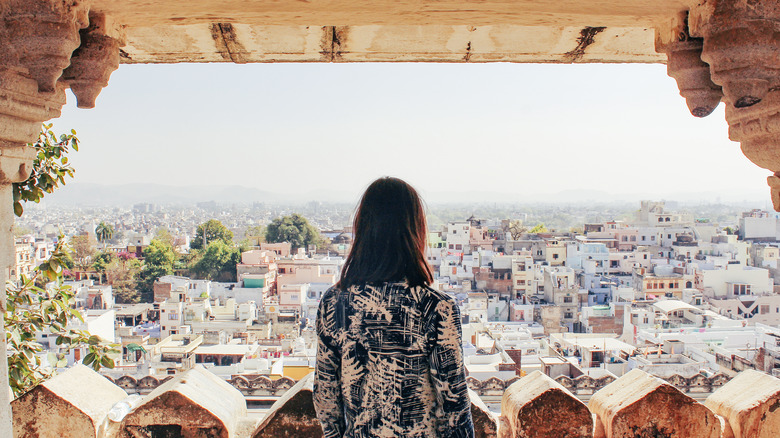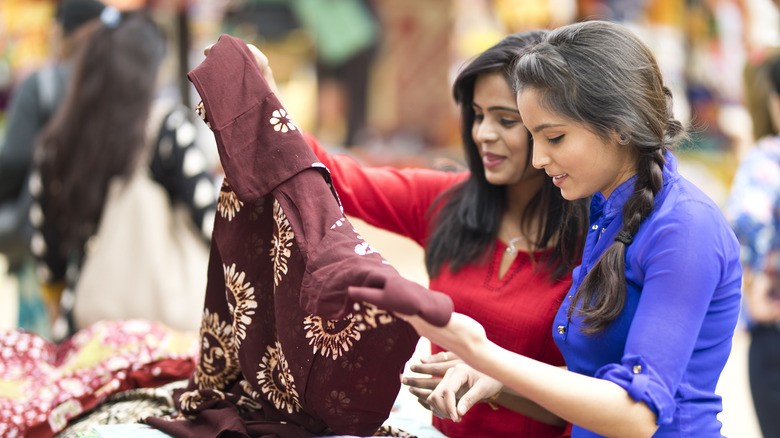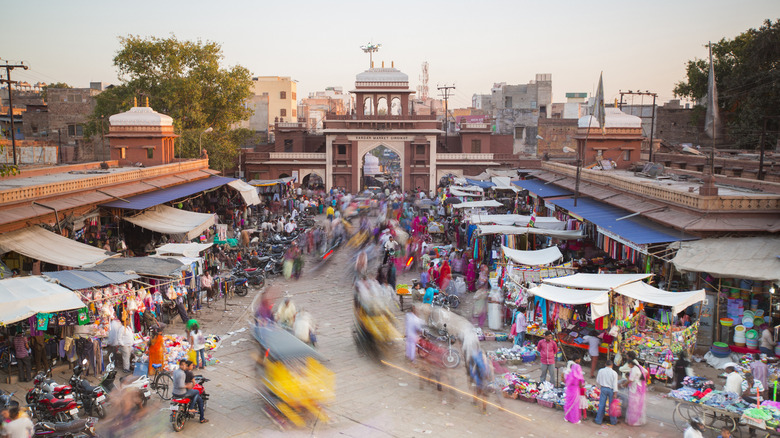Why Tourists Should Pack This Unexpected Article Of Clothing For A Trip To India
A trip to India offers an adventure that's as enriching as it is challenging. Among the different preparations travelers must make, from visas to vaccines, wardrobe might seem like the easiest thing to figure out. One would think that with average temperatures of 75 to 90 degrees Fahrenheit in regions like Goa, Mumbai, and Delhi, all you need is some shorts and T-shirts. Wrong. Long sleeves are actually the more important (and unexpected!) article of clothing you must bring.
India is the seventh-largest and most populous country in the world. It comprises 28 states and is home to thousands of different ethnic minorities, countless castes and tribes, and various spiritual denominations. Religion is taken very seriously in the country, and modest dress is expected for both men and women. Yes, you have the Naga Sadhus (a group of ascetic Hindu monks known for being naked in renunciation of the material world); however, they are the most austere exception.
Dressing modestly by opting for long sleeves and baggy clothes shows respect for Indian tradition, especially when visiting temples, mosques, and shrines. Conservative dress is expected in religious sites, neighborhoods, and towns (like Varanasi). This means long sleeves that cover the arms (shoulders, at the least) and long bottoms to cover past the knees. This is not a tourist-exclusive rule — it is a local standard. If you plan on visiting any holy site, from the Golden Temple in Amritsar to Mahabodhi Temple in Bodh Gaya, wear sleeves.
Practical pros of long sleeves
Beyond the modesty aspect, there is the practical one. India's climate is very diverse, ranging from the freezing Himalayan north to the beachy southern coasts. Regardless of the region, long-sleeved and loose-fitting garments offer invaluable protection against the Sun's harsh rays, preventing sunburn and heatstroke. India has an average UV index of 8.33, which is considered very high. With this UV rating, you can get a sunburn in less than 15 minutes.
The idea of wearing long sleeves and baggy clothes in a predominantly hot country might seem counterintuitive at first. However, clothing made from fabrics like cotton, linen, and silk, which are abundantly available and very popular in India, is exceptionally comfortable for the climate. These materials help absorb sweat and allow air circulation, keeping you cooler than synthetic fabrics or denim ever could. Additionally, loose-fitting garments are less restrictive, making long hours of travel, whether by train, bus, or foot, much more manageable.
In mosquito-prone regions, these clothes also act as a barrier against bites, offering added protection from diseases like malaria, dengue fever, and Japanese encephalitis. This is an important health risk to be aware of when traveling to India. Some of the most malaria-burdened states in India include Orissa, Jharkhand, and Chhattisgarh. Every year, 40 million people in India get infected by mosquito-borne diseases, and non-immune foreign travelers are especially vulnerable. Wearing long layers of baggy clothing can save you from something that can ruin your trip — and possibly your life.
Long sleeves for versatility and modesty
Packing light is a priority for many travelers, and versatile clothing items like long-sleeved shirts and loose trousers or skirts (especially made from lightweight fabrics) can save pounds on carry-on luggage. These pieces can be mixed and matched to create different looks and are suitable for a range of activities, from exploring bustling city markets to dining at restaurants. India also has many busy public areas that can be polluted and dirty — long sleeves and bottoms can give you that extra shield and be easily washed afterward.
While it's nearly impossible for foreigners to completely blend in with the local population in India, dressing more like the locals can certainly reduce unwanted attention. Tourists, especially women, might find that modest clothing helps minimize stares and provides a layer of privacy in crowded spaces. Revealing clothing may attract looks, catcalls, and even unconsented photos. Metropolitan cities such as Mumbai have more liberal attitudes toward less modest clothing, while other parts, like Uttar Pradesh and Rajasthan, are much more traditional.
However, if in doubt, it's wisest to err on the side of more conservative clothing. Traditional Indian clothing, such as the shalwar kameez for men and the sari for women, is beautiful and hard to resist — but it may earn you a few odd looks if worn as a foreigner. In this case, Western clothing will do just fine, so long as it matches the modesty of other people around you. To be a respectful tourist when visiting India, pack some long sleeves and thank us later!


